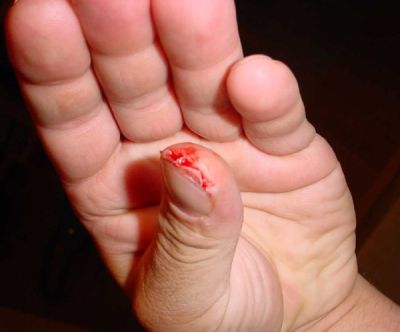Chip Clearing and Dents in Mouldings
Dents that occur when chips are pressed back into the wood by cutter ends are related to problems with the dust collector's suction. July 18, 2008
Question
I've just started running a new crown mould - 5 1/2" wide, soft maple. I'm seeing some "dents" or depressed spots in the deepest part of the cut. Is this coming from chips being pressed back into the wood? I'm using 2 knives HSS at 6000 rpm. Suction/extraction problem? Would a 3 wing head help?
Forum Responses
(Solid Wood Machining Forum)
From contributor J:
What type of machine are you running this on? What type of set-up? A little more description would help get better answers. What is your dust collection cfm?
From the original questioner:
The machine is a Bridgewood 757.5 head. Cut sequence is btm, right side for 45, left side for 45, top for profile and then btm. Not sure of the cfm, but have run other mouldings this wide and have not encountered this before. There doesn't seem to be a decreased amount of suction on the top cutter or any of the others. One thing, the outside of the crown is perfect and that's where the suction hose is located.
From contributor R:
What is the depth of cut? It sounds like you don't have enough cfm in the dust collection system. Indentations are caused by wood chips slapping back into the finish product, they look like little rain drops or tear drops. Are there other ports connected to the system that you can close. Does the same thing happen with other woods types? Yes a three wing cutterhead would help, a four wing would be better, but remember your tooling costs are increased as well. A general rule of thumb would be to have at least 1000 cfm per cutterhead cutting. I hope that helps you, I am sure other will add more.
From contributor M:
I had the same problem until I hooked up a second collector to the machine and use it only for the top head. I have a logosol ph260 machine. A little compressed air directed at the top head will help also. I really need a more powerful dc system.
From contributor P:
Check the knives, how much clearance is there from the lowest portion of the knife and the body of the cutter head? If there is too little room the chips will not be able to escape fast enough. A simple fix for this is just to move the knives out of the head a little further. If you cannot get better dust collection, or air hoses to help blow the excess away, then I would flip the whole profile upside down and let gravity help you out.
Keep in mind that is not a simple set up, and will take someone with a good bit of experience and an ability to think out of the box to do it right.
From contributor J:
I agree with everything that’s been said so far. The only solution (or attempt at one) for a quick fix would be to slow your feed rate down. This will give more time to let the (now smaller) chips to escape. The downside to this is your knives may dull quicker but that’s still better than hand sanding 5 1/2" crown moulding.
From contributor R:
Some things to think about before going to Contributor P's solution are:
1. Extending the knives out a bit will increase your cutting circle, thus inviting snipe because you will have to open your bedplates, pressure shoe, chipbreaker to incorporate the new cutting circle. Now this is also sucking more outside air, decreasing your cfm even more. Be careful not to exceed the safety limit on the cutterhead.
2. Flipping the profile upside down may work against you. If you’re cutting the bevels from the side heads you will be taking away some lumber that is under the feed rollers thus decreasing some of your feed power where the wood is gone.
3. Your reference point on your tooling will no longer be axail constant because you will be referencing from the other side. If you have an opti scope it will be helpful.
4. Slowing down the feed rate as Jason suggested will help, but don’t fall below 20 feet per minute if you have 6000 rpm, you will greatly decrease your tool life.
From contributor P:
Forgive me if I am reiterating what has already been said, I do it only for the sake of safety and knowledge of anyone who reads this! The tooling will definitely have no relation to axial constant any more. You would be setting up blind.
It would be a very difficult set up. I have done it before, but would not suggest it unless you understand every facet of your machine.
Your cutting circle should always be checked any time you put a new head on or make an adjustment to the knives. Just make sure you have the proper clearance from the head body, no more, no less. Slow the feed down if you can. I would imagine this is a short run, so you should be ok with knife life, unless it is full of mineral of something.
From contributor T:
All good advice above, but you may want to try something simple first. My experience with some of the off brand moulders has shown me they sometimes lack attention to details. Check the suction dust hood for its position above the spindle. I have often found that some hoods are designed poorly not giving direct airflow directly above the spindle. Your statement about the outside being fine leads me to suspect this may be the culprit. Take a spacer, place it behind the cutterhead effectively trying to get it more in line with the airflow and out of any dead spots under the hood.
